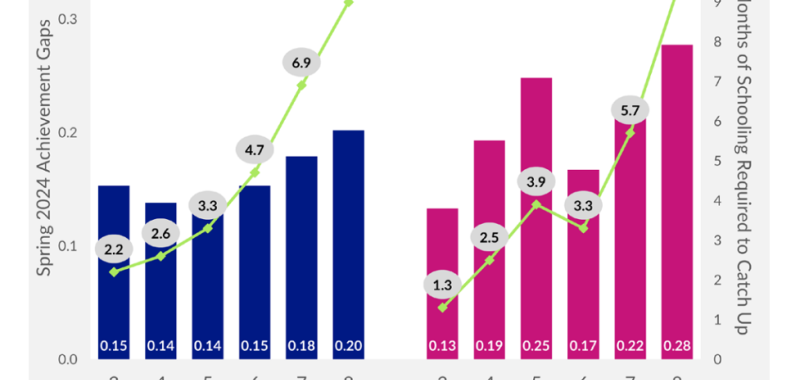Curriculum Associates did not detect as much deterioration as NWEA, but did find widespread stagnation in 2023-24, according to a report released on August 19, 2024. Their researcher Kristen Huff described the numerical differences as tiny ones that have to do with the fact that these are different tests, taken by different students and use different methods for crunching the numbers. The main takeaway from all the reports, she said, is the same. “As a nation, we are still seeing the lasting impact of the disruption to schooling and learning,” said Huff, vice president of assessment and research at Curriculum Associates.
In short, children remain behind and haven’t recovered. That matters for these children’s future employment prospects and standard of living. Ultimately, a less productive labor force could hamper the U.S. economy, according to projections from economists and consulting firms.
It’s important to emphasize that individual students haven’t regressed or don’t know less now than they used to. The average sixth grader knows more today in 2024 than he or she did in first grade in 2019. But the pace of learning, or rate of academic growth, has been rocky since 2020, with some students missing many months of instruction. Sixth graders in 2024, on average, know far less than sixth graders did back in 2019.
Renaissance, a third company, found a mottled pattern of recovery, stagnation and deterioration depending upon the grade and the subject. (The company shared its preliminary mid-year results with me via email on Aug. 14, 2024.) Most concerning, it found that the math skills of older students in grades eight to 12 are progressing so slowly that they are even further behind than they were after the initial pandemic losses. These students were in grades four through eight when the pandemic first hit in March 2020.
On the bright side, the Renaissance analysis found that first grade students in 2023-24 had completely recovered and their performance matched what first graders used to be able to do before the pandemic. Elementary school students in grades two to six were making slow progress, and remained behind.
Curriculum Associates pointed to two unexpected bright spots in its assessment results. One is phonics. At the end of the 2023-24 school year, nearly as many kindergarteners were on grade level for phonics skills as kindergarteners in 2019. That’s four out of five kindergarteners. The company also found that schools where the majority of students are Black were showing relatively better catch-up progress. “It’s small, and disparities still exist, but it’s a sign of hope,” said Curriculum Associates’s Huff.
Here are three charts and tables from the three different testing companies that provide different snapshots of where we are.
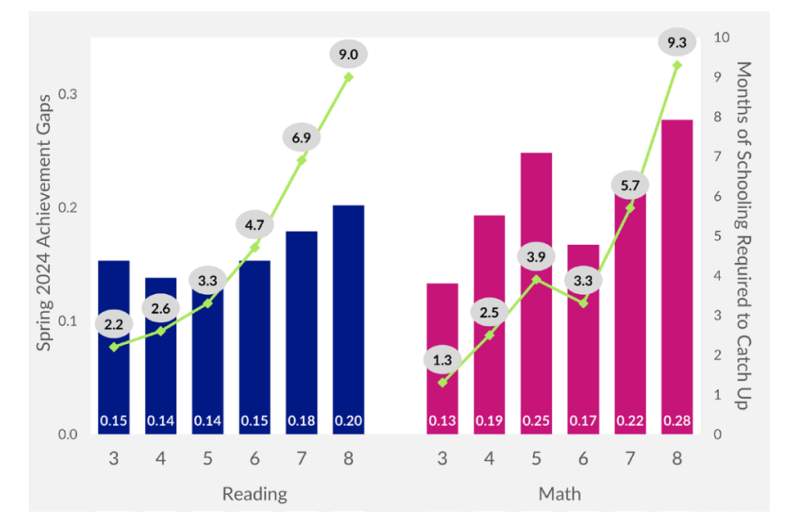
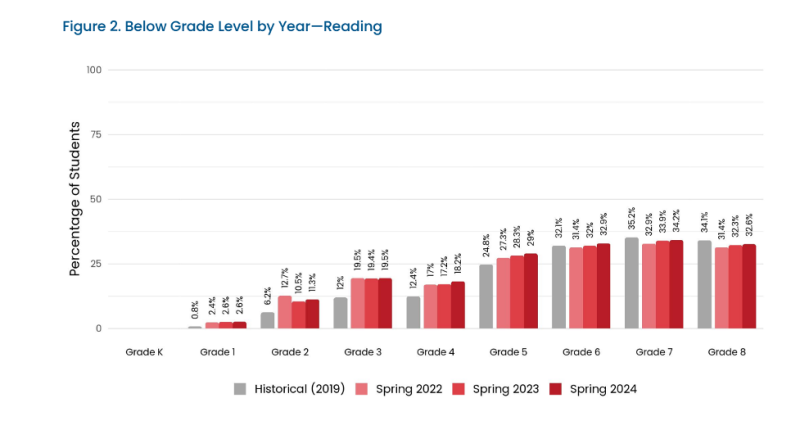
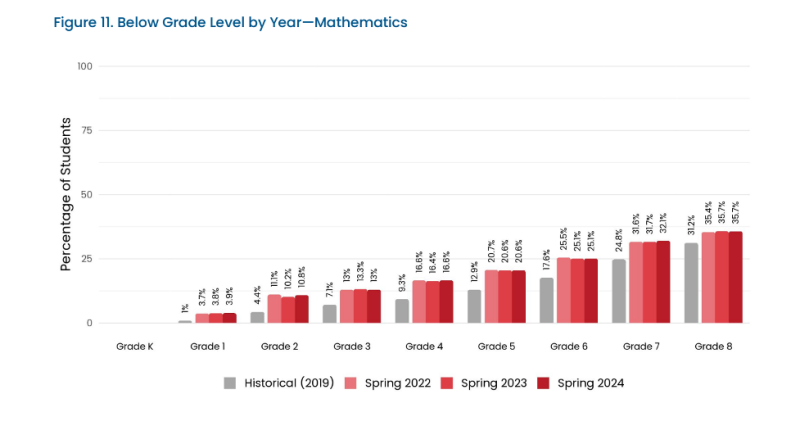
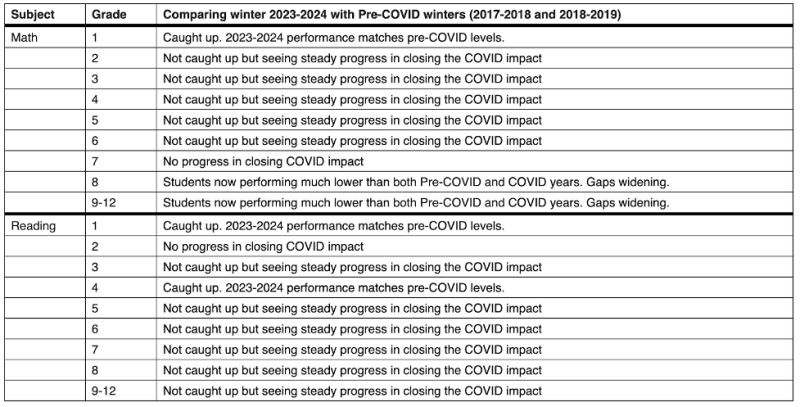
Understanding why recovery is stagnating and sometimes worsening over the past year is difficult. These test score analyses don’t offer explanations, but researchers shared a range of theories.
One is that once students have a lot of holes in their foundational skills, it’s really hard for them to learn new grade-level topics each year.
“I think this is a problem that’s growing and building on itself,” said NWEA’s Lewis. She cited the example of a sixth grader who is still struggling to read. “Does a sixth-grade teacher have the same skills and tools to teach reading that a second or third grade teacher does? I doubt that’s the case.”
Curriculum Associates’s Huff speculated that the whole classroom changes when a high percentage of students are behind. A teacher may have been able to give more individual attention to a small group of students who are struggling, but it’s harder to attend to individual gaps when so many students have them. It’s also harder to keep up with the traditional pace of instruction when so many students are behind.
One high school math teacher told me that she thinks learning failed to recover and continued to deteriorate because schools didn’t rush to fill the gaps right away. This teacher said that when in-person school resumed in her city in 2021, administrators discouraged her from reviewing old topics that students had missed and told her to move forward with grade-level material.
“The word that was going around was ‘acceleration not remediation’,” the teacher said. “These kids just missed 18 months of school. Maybe you can do that in social studies. But math builds upon itself. If I miss sixth, seventh and eighth grade, how am I going to do quadratic equations? How am I going to factor? The worst thing they ever did was not provide that remediation as soon as they walked back in the door.” This educator quit her public school teaching job in 2022 and has since been tutoring students to help them catch up from pandemic learning losses.
Chronic absenteeism is another big factor. If you don’t show up to school, you’re not likely to catch up. More than one in four students in the 2022-23 school year were chronically absent, missing at least 10 percent of the school year.
Deteriorating mental health is also a leading theory for school struggles. A study by researchers at the University of Southern California, released Aug. 15, 2024, documented widespread psychological distress among teenage girls and preteen boys since the pandemic. Preteen boys were likely to struggle with hyperactivity, inattentiveness and conduct, such as losing their temper and fighting. These mental health struggles correlated with absenteeism and low grades.
It’s easy to jump to the conclusion that the $190 billion that the federal government gave to schools for pandemic recovery didn’t work. (The deadline for signing contracts to spend whatever is left of that money is September 2024.) But that doesn’t tell the whole story. Most of the spending was targeted at reopening schools and upgrading heating, cooling and air ventilation systems. A much smaller amount went to academic recovery, such as tutoring or summer school. Earlier this summer two separate groups of academic researchers concluded that this money led to modest academic gains for students. The problem is that so much more is still needed.

